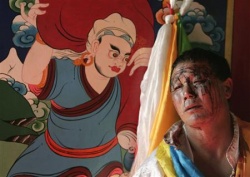Tibetans welcome mountain spirits in faith ceremony
By Christina Hu and Lucy Hornby
Manbengya, a 47-year-old Tibetan man who serves as medium for the warrior mountain god Amyesyullha, rests after Amyesyullha left his body at the temple in Rebkong, Qinghai province, August 11, 2009. Every summer the green hills of Rebkong are home to unique celebrations during which local Tibetans believe the mountain gods visit villagers - and each other - through human mediums. Picture taken August 11, 2009.
Every summer the green hills of Rebkong are home to unique celebrations during which local Tibetans believe the mountain gods visit villagers -- and each other -- through human mediums.
Rebkong, known in Chinese as Tongren in Qinghai province, has dozens of monasteries that practice Tibetan Buddhism, in which monks and nuns strive for enlightenment.
But the region's traditions also stem from the animist Bon religion that Tibetans practiced before Buddhism was introduced.
During the festival of Lurol, which falls during the sixth lunar month, worshipping villagers believe the spirits descend from the mountains and enter the bodies of mediums who have inherited the role from their fathers.
Dressed in special clothes, his long hair carefully cut and braided, Damtsengbon waits for his spirit, Amyesrmachen, the most sacred mountain god in the region. Other villagers call the spirit's name while Damtsengbon, who like many Tibetans only goes by one name, enters a trance, twitching and jerking.
"I am the third generation to channel this god, so it is not just about me. For three generations the god has manifested himself through us, and even living Buddhas recognize this," Damtsengbon told Reuters. A "living Buddha" is a Tibetan monk who is considered to be an exemplary holy figure.
"I think it's a way for me to serve my people. It keeps us together and protects us, so it's an honor to serve them.
What may seem unfathomable to Westerners, even those versed in Tibetan Buddhism, is central to the folk religion practiced by many Tibetans in traditional communities.
"Tibetan Buddhism has a very clear distinction between what they call lha-choe and mi-choe, godly religion and person religion," said Robbie Barnett, a Tibet expert at Columbia University in New York.
"The first refers to the form of Buddhism done mainly by monks and adepts to pursue enlightenment, and the second means the form done mainly by ordinary lay people to improve behavior and get a better rebirth," Barnett said. "Most Tibetans are primarily focused on the second."
Mediums like Damtsengbon purify themselves for seven days, by listening to senior holy men chant scriptures, and avoiding alcohol, cigarettes and women.
Normally a quiet man and a graceful dancer, Damtsengbon dances with rapid, awkward movements during his trance.
Although other Tibetan areas also have famous oracles, the Rebkong region is unique for its dances, in which the whole village participates.
When another medium receives the spirit of Amyesyullha, the local warrior spirit, he cuts his forehead with a knife and smears the blood on worshippers to heal them.
Men from the villages have their cheeks pierced with steel needles to excise disease from the mouth, a painful ritual that involves little blood.
"The act of piercing the mouth and back is a part of the blood sacrifice ritual," said Nanjia Cairang, a researcher at the China Tibetology Research Center in Beijing.
"Villagers sacrifice to the gods through their own bodies. This act represents sincerity and excitement."
After the festival, Damtsengbon returns to his normal self with no memory of the trance. He works on the grasslands and has married a Han Chinese woman, the first in his village to do so.
(Writing by Lucy Hornby; Editing by Bill Tarrant and Miral Fahmy)
